| This article needs additional citations for verification. Please help improve this article by adding citations to reliable sources. Unsourced material may be challenged and removed. Find sources: "List of largest craters in the Solar System" – news · newspapers · books · scholar · JSTOR (March 2024) (Learn how and when to remove this message) |
Following are the largest impact craters on various worlds of the Solar System. For a full list of named craters, see List of craters in the Solar System. The ratio column compares the crater diameter with the diameter of the impacted celestial body. The maximum crater diameter is 157% of the body diameter (the circumference along a great circle).
| Body | Crater | Crater diameter | Body diameter | Ratio | Images | Notes |
|---|---|---|---|---|---|---|
| Mercury | Caloris | 1,550 km (963 mi) | 4,880 km | 32% | 
|
|
| Rembrandt | 715 km (444 mi) | 15% | 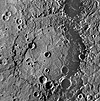
|
|||
| Venus | Mead | 280 km (170 mi) | 12,100 km | 2% |  |
|
| Earth | Vredefort | 250–300 km (160–190 mi) | 12,740 km | 2% | 
|
|
| Chicxulub crater | 182 km (113 mi) | 1.4% | 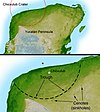
|
Cause or contributor of the Cretaceous–Paleogene extinction event | ||
| Sudbury Basin | 130 km (80 mi) | 1% | 
|
|||
| Moon (moon of Earth) |
Procellarum | 3,000 km (2,000 mi) | 3,470 km | 86% | 
|
Not confirmed as an impact basin. |
| South Pole–Aitken basin | 2,500 km (1,600 mi) | 70% | 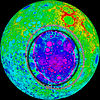
|
|||
| Imbrium | 1,145 km (711 mi) | 33% | 
|
|||
| Mars | North Polar Basin | 10,600 × 8,500 km (6,550 × 5,250 mi) | 6,780 km | 125–155% | 
|
Not confirmed as an impact basin |
| Utopia | 3,300 km (2,100 mi) | 50% | 
|
Largest confirmed impact basin on Mars and in the Solar System | ||
| Hellas | 2,300 km (1,400 mi) | 34% | 
|
Largest visible crater in the Solar System | ||
| Isidis | ~1,900 km (1,200 mi) | 28% | 
|
Heavily degraded to the northeast | ||
| Argyre | 1,700 km (1,100 mi) | 25.1% | 
|
May have an outer ring 2750 km in diameter | ||
| Vesta (asteroid) | Rheasilvia | 505 km (310 mi) | 529 km (569 km) | 90% | 
|
See also: List of tallest mountains in the Solar System |
| Veneneia | 395 km (250 mi) | 70% | 
|
Partially obscured by Rheasilvia | ||
| Ceres (dwarf planet) | Kerwan | 284 km (180 mi) | 952 km | 30% | 
|
Faint shallow crater, below the center of this image. |
| Yalode | 271 km (170 mi) | 28% | 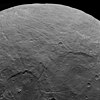
|
|||
| Hygiea (asteroid) | Serpens | 180±15 | 434 ± 14 km | 40% | ||
| Ganymede (moon of Jupiter) |
Epigeus | 343 km (213 mi) | 5,270 km | 6.5% | 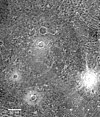
|
|
| Callisto (moon of Jupiter) |
Valhalla | 360 km (224 mi) | 4,820 km | 7.5% | 
|
|
| Heimdall | 210 km (130 mi) | 4% | (no good images have been taken) | |||
| Mimas (moon of Saturn) |
Herschel | 139 km (86 mi) | 396 km | 35% | 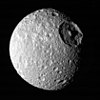
|
See also: List of tallest mountains in the Solar System |
| Tethys (moon of Saturn) |
Odysseus | 445 km (277 mi) | 1,060 km | 42% | 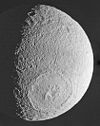
|
|
| Dione (moon of Saturn) |
Evander | 350 km (220 mi) | 1,123 km | 34% | 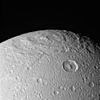
|
|
| Rhea (moon of Saturn) |
Mamaldi | 480 km (300 mi) | 1,530 km | 31% | 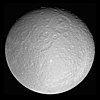
|
|
| Tirawa | 360 km (220 mi) | 24% | 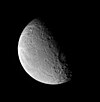
|
|||
| Titan (moon of Saturn) |
Menrva | 392 km (244 mi) | 5,150 km | 7.5% | 
|
|
| Iapetus (moon of Saturn) |
Turgis | 580 km (360 mi) | 1,470 km | 40% | 
|
|
| Engelier | 504 km (313 mi) | 34% | 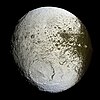
|
|||
| Gerin | 445 km (277 mi) | 30% | 
|
Gerin is overlain by Engelier | ||
| Falsaron | 424 km (263 mi) | 29% | 
|
|||
| Titania (moon of Uranus) |
Gertrude | 326 km (203 mi) | 1,580 km | 21% | 
|
Little of Titania has been imaged, so it may well have larger craters. |
| Pluto (dwarf planet) | Sputnik Planitia basin | ca. 1,400 × 1,200 km average: ~1,300 km |
2,377 km | 54.7% | 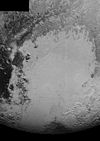
|
Partially infilled by convecting Nitrogen ice, heavily eroded |
| Burney | 296 km (184 mi) | 12.5% | 
|
Heavily degraded, difficult to see | ||
| Charon (moon of Pluto) |
Dorothy | ca. 261 km (162 mi) | 1,207 km | 21% | 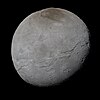
|
Crater at upper right overlapping Mordor Macula |
See also
References
- McGill, G. E. (1989-03-10). "Buried topography of Utopia, Mars: Persistence of a giant impact depression". Journal of Geophysical Research. 94: 2753–2759. Bibcode:1989JGR....94.2753M. doi:10.1029/JB094iB03p02753.
- Tornabene, Livio L.; Moersch, Jeffery E.; McSween, Harry Y.; et al. (October 2008). "Surface and crater-exposed lithologic units of the Isidis Basin as mapped by coanalysis of THEMIS and TES derived data products". Journal of Geophysical Research. 113 (E10). Bibcode:2008JGRE..11310001T. doi:10.1029/2007JE002988.
- ^ Hiesinger, Harald; Head, James W., III (August 2002). "Topography and morphology of the Argyre Basin, Mars: implications for its geologic and hydrologic history". Planetary and Space Science. 50 (10–11): 939–981. Bibcode:2002P&SS...50..939H. doi:10.1016/S0032-0633(02)00054-5.
{{cite journal}}: CS1 maint: multiple names: authors list (link) - ^ Rheasilvia and Veneneia are 95% and 75% of the mean diameter of Vesta, 529 km. However, the mean is affected by the craters themselves. They are 89% and 69% the mean equatorial diameter of 569 km.
- ^ Planetary Names: Search Results
- USGS
- USGS
- McGovern, P. J.; White, O. L.; Schenk, P. M. (December 2021). "Tectonism and Enhanced Cryovolcanic Potential Around a Loaded Sputnik Planitia Basin, Pluto". Journal of Geophysical Research: Planets. 126. Bibcode:2021JGRE..12606964M. doi:10.1029/2021JE006964.
| Solar System | |||||||||||||||||||||||||
|---|---|---|---|---|---|---|---|---|---|---|---|---|---|---|---|---|---|---|---|---|---|---|---|---|---|
| |||||||||||||||||||||||||
| Lists | |||||||||||||||||||||||||
| Hypothetical | |||||||||||||||||||||||||
| See also: Formation and evolution of the Solar System, list of the Solar System's objects by discovery date, by orbit, and by radius or mass, and the Solar System Portal | |||||||||||||||||||||||||
